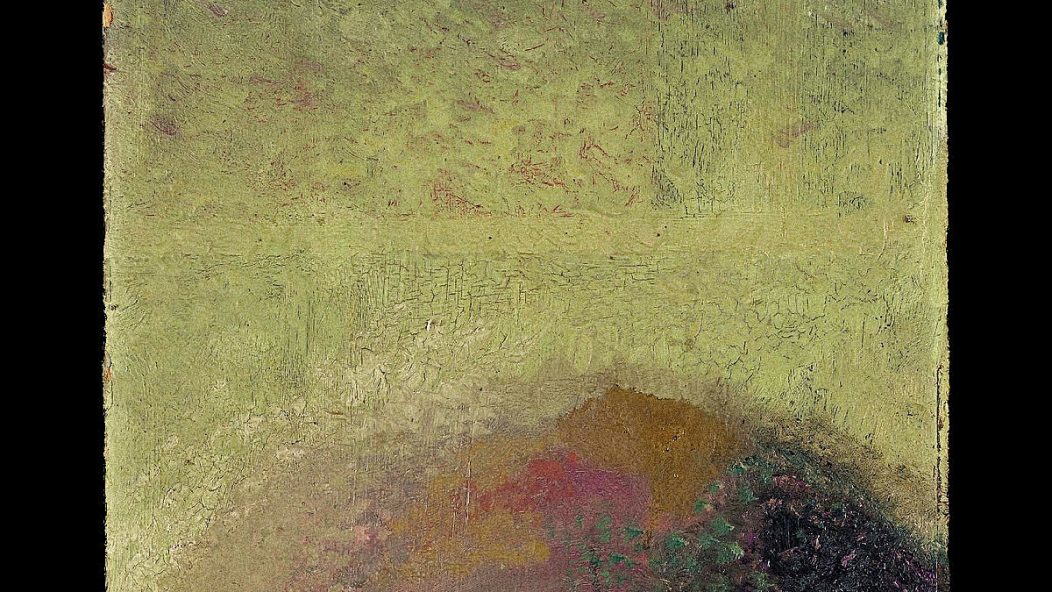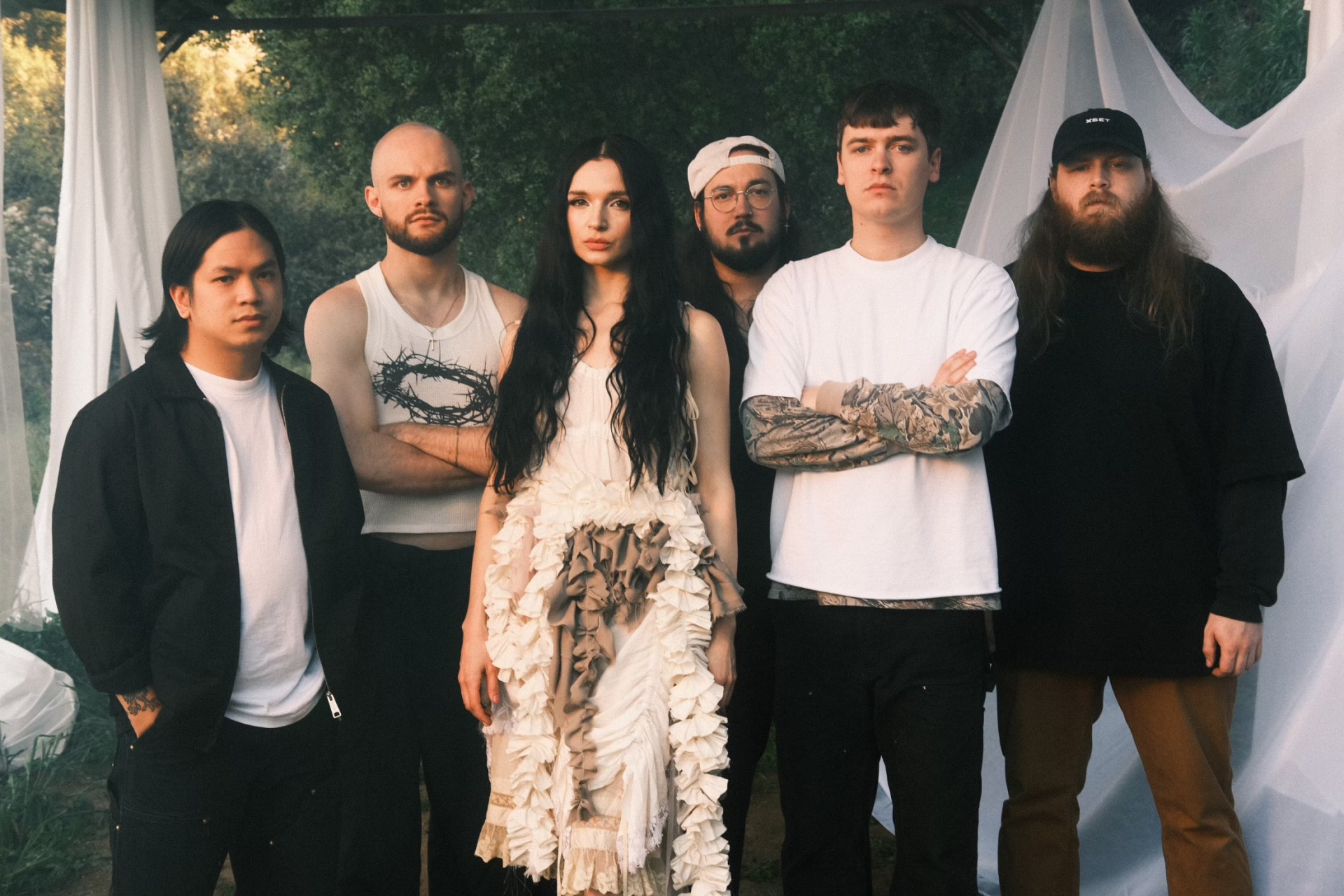
An Olympian Task: A Conversation with Jute Gyte's Adam Kalmbach
Jute Gyte‘s dualistic world is a frightening one to behold. Microtonal guitars, wild rhythms, and complete hellscapes; Jute Gyte is the sound of an all-consuming, waking nightmare, but there is an important aspect to remember. Jute Gyte is still black metal. It’s strange to think of something so alien sounding as something which can be grounded by such a simple term, in the same way listening to Éliane Radigue’s synthesizer works can at times transcend the word “modern” and move into a sphere all its own.
On his latest album Mitrealität, Jute Gyte mastermind Adam Kalmbach reins in his creation, one which had found new levels of outrageousness in the past half decade since he had his guitar retrofitted with a quartertone neck (double the frets in the same amount of space, splitting each semitone in half). As he found new heights at the forefront of microtonal metal, even usurping the throne from Ron Sword, who altered his guitar, Kalmbach’s works became more expressionistic and unbridled over time–Jute Gyte calculatedly lost its grip on musical reality and transcended into a realm all its own, and now it’s time to come back and teach the world exactly how to master these new, academic elements.
In a new interview, Adam Kalmbach discusses Jute Gyte’s history, ever-changing approach, and his forays into the dungeon synth world.
…
…
What does Jute Gyte mean to you in 2021 when compared to its first few years in the early 2000s?
In a sense, not much has changed–I’m still trying to create music that I haven’t heard before, and releasing music regularly as part of a creative practice is still important to me. I’m more willing to trust my musical instincts than I was fifteen years ago, and I have the benefit of being able to review my earlier music to see what worked and what didn’t.
As you become more comfortable with the microtonal (quarter tone) neck you had made by luthier Ron Sword, do you feel you’ve become more daring with your ideas?
I think I’ve become better at translating the sounds I imagine to something playable on the instrument and in the quarter-tone tuning system. When I first began playing the quarter-tone guitar, the feeling of freedom at being able to play combinations of notes I’d never heard before was exhilarating. That feeling has inevitably faded somewhat as I’ve become more familiar with the tuning system, but the awareness that novel pitch combinations can create powerful experiences has stayed with me and led me to experiment with other ways to use tuning.
Though the casual listener will hear a cacophony of sounds and unfamiliarity within Jute Gyte, I imagine you hear it in an entirely different way. How do you hear music, especially that which moves outside of Western harmony and form?
Fundamental questions like “how do you hear music?” are surprisingly hard to answer. When I’m listening to music, I find it useful to note the boundaries–find the highest and lowest sounds, the softest and loudest sounds, the shortest and most sustained sounds, and the ratio of sounds and rests–and then track what happens within these boundaries, and how all these boundaries change over time. I say “sounds” rather than instruments because an instrument is just one kind of thing that makes sounds. I’ve been listening to Under a Funeral Moon recently and am always amazed by the floor tom, which sounds like no earthly instrument and instantly reconfigures the musical space.
Jute Gyte is one of metal’s truly radical artists, looking beyond the popular post-Romantic stylistic in which we reside and towards sound experiments in the late 19th century and beyond, but Young Eagle and Old Ways didn’t make your musical evolution immediately obvious (I started to “get it” around Verstiegenheit). Was Jute Gyte always meant to move in this academic and challenging direction?
The last track I wrote for Young Eagle was the title track, which used uncommon meters and several layers of guitar. This became sort of a template for the next several albums–avoid 4/4 [meter] and focus on verticality. A lot of metal music is very horizontal–a track will have several riffs or sections in sequence, but each section will only have a few independent parts. This is a perfectly reasonable way to write, but I was more interested in writing tracks with fewer sections and more going on simultaneously in each section. In a way this is still what I’m doing, but as I’ve experimented over the years the variety of musical material I feel comfortable using has expanded. My goal isn’t to create challenging music, but to make something new that rewards careful listening and hopefully contributes something of value to the musical traditions that have enriched my life. I’m a bit uncomfortable with the academic designation because I’m not an academic and because “academic black metal” somehow sounds even drearier than “funeral doom metal.”
With melody, harmony, and rhythm now fully dissected, where do you see Jute Gyte’s black metal half moving? Is there a concept or musical practice you see yourself including in the future which hasn’t already been addressed in this project?
For several albums I was engaging with music through various abstraction layers–mostly related to the organization of pitch and rhythm–that operate at a remove from the final experiential result, which in music is always a multidimensional sonic space occupied by the listener. Lately I’ve been moving away from abstractions and toward working directly with the sounds themselves to have more comprehensive control of these musical spaces. I think writing the track “New Plastic from Birefringence was a turning point: it’s a track with serialized pitches and durations (serialism is an excellent abstraction layer) that sounded desiccated and arid until I finally hit upon serializing a great many layers of signal processing, at which point the scaffolding of pitches and durations seemed to disappear and the track came to life as a sound-world. In another sense, this focus on timbre and texture is a return to the style of Old Ways, an album that is at least as much about texture as it is about riffing.
I often think of the guitar’s fretboard in a very “shape” oriented way, and your guitar doubles the possibilities by subdividing each note one time, creating quarter tones. When dealing with microtonality, how do you decipher which note subdivision to use when constructing a melody or idea?
If I understand you correctly, you’re referring to the shapes scales make across the fretboard. In that regard, the quartertone or 24EDO (24 equal divisions of the octave) tuning has some interesting properties. One of the most striking intervals it makes available is the neutral second, which is halfway between a minor second and a major second. All the neutral intervals are noteworthy but I find the neutral second is especially effective at establishing a different tonal space than standard western tuning. The 8EDO scale, which is macrotonal, meaning that it uses intervals larger than the ones used in standard western tuning, can be played as a series of neutral seconds. You can also use quartertones to get quite close to 5EDO by playing a series of “ultra seconds,” which are halfway between a major second and a minor third. It can be interesting to set multiple scales against each other contrapuntally.
I’ve used all sorts of methods to determine which note should come next, and am particularly fond of combining serial and aleatoric approaches, but if I simply want to write a melody it’s often best to sit down with the instrument and proceed intuitively. I frequently change tunings so I can get novel results from familiar fretting patterns. And sometimes I find the note I want is not available on the instrument so I manually retune certain notes in the guitar tracks after recording them.
You’re currently running a Bandcamp campaign to press your latest black metal album, Mitrealität, on vinyl. This isn’t the first time you’ve self-released a Jute Gyte album on this format, but why take the campaign approach now?
People frequently ask if I plan to release more of my music on vinyl, but self-releasing a record is daunting–the logistics of record pressing are complex, the up-front costs are high, and warehousing the records takes a lot of space. Bandcamp’s vinyl campaigns address these concerns and present an opportunity to release my music on vinyl more consistently. (Which is not to say I wouldn’t be interested if a label wanted to undertake the Olympian task of pressing my back catalog.)
You’ve been revisiting older releases from the past decade and uploading them to your Bandcamp page over the past few months. As a more advanced and accomplished artist now, how has the process of revisitation been?
The tracks on those compilations were written for various cassettes, splits, and EPs, and were early attempts at writing long-form, semi-improvised tracks, where I recorded myself playing various short phrases that I later collaged together to create riffs and sections. I ended up writing a lot of Birefringence and parts of Mitrealität that way, so it was interesting to revisit my earlier attempts at the process. I think I’ve done enough of the sprawling style of writing for now and plan to return to more concise forms in the future.
You cite quite the literary list when explaining Mitrealität. How do you go about expressing literary influence in your music?
Those lists include artists and works that influenced the writing of the album’s music and lyrics, as well as writers I lifted lines or phrases from in my lyrics. I spent several months reading The Tunnel by William Gass while writing this album, and it was a big influence on both the lyrical themes and the sound of the album–there are passages in that novel that are so acutely observed and comprehensively described that they have an almost hallucinatory clarity, and achieving similar effects musically became one of my major goals.
You were rumored to and ultimately discovered to have created a large number of dungeon synth/drone/ambient projects like Abandoned Places and Erdstall. What led you to this genre specifically and do you still make dungeon synth?
The period following the codification of dungeon synth as a genre was fascinating, partly because the canonical “first wave” works were so few and so varied. There was a sense that the genre was wide open for exploration that I found exciting, and I created several anonymous projects to experiment with the possibilities of the style. The last dungeon synth music I released was Voormithadreth’s The Quest of Iranon from 2017. I felt, and still feel, that that album is likely the best work I’m capable of in the genre, so I chose to step away. It’s rare for me to revisit music once I’ve released it, but I return to that album a few times a year. I also felt that it might be worth merging that branch of my work back to the trunk and incorporating what I’d learned from dungeon synth into my work as Jute Gyte.
I suppose I should address the anonymity of these projects. In addition to the suitability of anonymity to the genre’s aesthetics, these projects were released at a time when my work as Jute Gyte was starting to get more attention after a decade where I had few listeners, and I think I found it a relief to be able to simply release music anonymously and without context.
When you were active as a dungeon synth artist and under so many monikers, how did you find yourself dividing up ideas while maintaining a sense of identity for each project?
Each project was an experiment with a different sound palette–like a project using only Mellotron samples–and/or compositional process–like gradually increasing the droniness and dissonance of a project’s releases. The first and last dungeon synth projects I did, Abandoned Places and Voormithadreth, both used FM synthesis, which has a gritty, uncanny quality that I think works well for dungeon synth but which hadn’t been used by any of the early dungeon synth artists. For Abandoned Places everything was sequenced in Finale (a music notation software), but for Voormithadreth I wrote the tracks on a piano, then performed them on a hardware FM synth running through a blown-out practice amp. A lot of the Abandoned Places tracks are chromatic inversions and/or retrogrades of each other, meaning that one track’s notes are mirrored vertically (high notes become low, etc.) and/or horizontally (melodies and chord progressions are reversed) in another track. Similarly, the Voormithadreth tracks sometimes use Vince Persichetti’s mirrored hands technique, where each hand is playing the inversion of the other hand’s musical material.
You’ve maintained a low profile over the 19 years which comprise Jute Gyte’s history. Even though you’ve always been open about your name, people don’t really know a lot about Adam Kalmbach the person. Why maintain this level of near-anonymity?
I’ve tried to find a level of public presence that feels comfortable. For me, that means doing interviews and attempting to respond to emails (very slowly, sorry). I don’t use social media.
Though you explain your academic compositional approaches on a per-album basis on your Bandcamp page, how would you explain Jute Gyte’s current public self to a layperson?
Experimental music for close listening.
Even though you’ve released a library’s worth of black metal albums following 2007’s Young Eagle, it is worth noting that, according to each album’s bio and explanation, lengthy periods of time are spent on these albums (the most recent in the works between 2017 and 2020), with album timelines often overlapping each other. When creating these black metal albums, how do you keep your ideas separate? Is there a greater plan at work?
I’m generally writing these albums in groups of three, and I have a rough plan of the musical and thematic arc I want the albums to cover. Nothing is set in stone, but I usually have some musical elements in mind for each album as well as the cover art, album titles, and some of the song titles. This is useful to me because it frames the music as a continuous process rather than putting a lot of weight on each discrete album. With these guidelines in mind, sometimes I realize I’ve recorded something that would fit better on a later album. I recorded half of the guitar parts for “Prometheus Ends in Onan” while recording Birefringence, and the material didn’t fit that album–Birefringence is very pitch-centric and the “Prometheus” guitars were noisy slide-guitar – but it fit well with the more texture-oriented Mitrealität. Similarly, the guitars for “Palimpest” were recorded during sessions for Ship of Theseus, but for various reasons that track made more sense on Perdurance. In these cases, I set the material aside and finished writing and editing the tracks during the sessions for the next album.
You’ve been known to release lengthy (up to four hours with 2018’s Penetralia) electronic/concrete music albums and in relatively quick succession. What is the composition process like for these, and is the album length intentional?
Penetralia is sort of a compilation of material spanning over half my life that I wanted to release but could never get to cohere into standard album-length configurations. I eventually realized that it worked best as a much longer digital release. I started putting it together shortly after moving from Missouri to Washington and assembling the album felt a little like exorcising my hard drive and a little like creating a coda to that part of my life.
I recently released two pieces of long-form process music, Respice Finem and Diapason. Respice Finem is a piece about the gradual transformation of a sample according to an algorithm, and the length of the piece is determined by the rate of change. I experimented with several different rates, some shorter, some longer, before finding what seemed to me like the best fit for the material. Diapason is a quarter-tone serialized mensuration canon for processed organ samples. The musical materials are simple–the series is two interlocking circles of fifths a quarter-tone apart and each of the canon’s voices are a fifth apart–but the tones are sustained for a very long time to create evolving interference patterns. My hope is that the long-held tones and evolving patterns have a defamiliarizing effect similar to semantic satiation (the way a word repeated too many times seems to lose its meaning) and allow the listener to experience a linear succession of pitches played on a common instrument from a new perspective.
Aside from a handful of releases on labels like Black Horizons and Ratten im Gemäuer, Jute Gyte remains an independent band, operating under your own Jeshimoth Entertainment label since the early 2000s. What is it like being an independent artist in 2021 compared to Jute Gyte’s early days?
It would be hard to overstate what a positive difference Bandcamp has made for independent musicians. It’s the most artist-friendly platform I’ve ever encountered and I’m not sure what my musical existence would be like without it. And I have been very fortunate to work with Black Horizons, Blue Tapes, and the amazing Lukas of Ratten im Gemäuer, who has created beautiful box sets of my black metal albums.
Do you follow the rest of the microtonal and/or academic black metal scene?
I’m not very good at keeping up with new music, but I think the new Victory Over the Sun album is really good. Lately I’ve been listening to Éliane Radigue’s Trilogie De La Mort, Robert Hood’s Internal Empire, Ildjarn’s Landscapes, and a remarkable album of Georgian vocal polyphony by Ensemble Basiani called Georgia: Sacred and Secular Vocal Polyphony.
…
Help fund a vinyl pressing of Mitrealität on Bandcamp.










